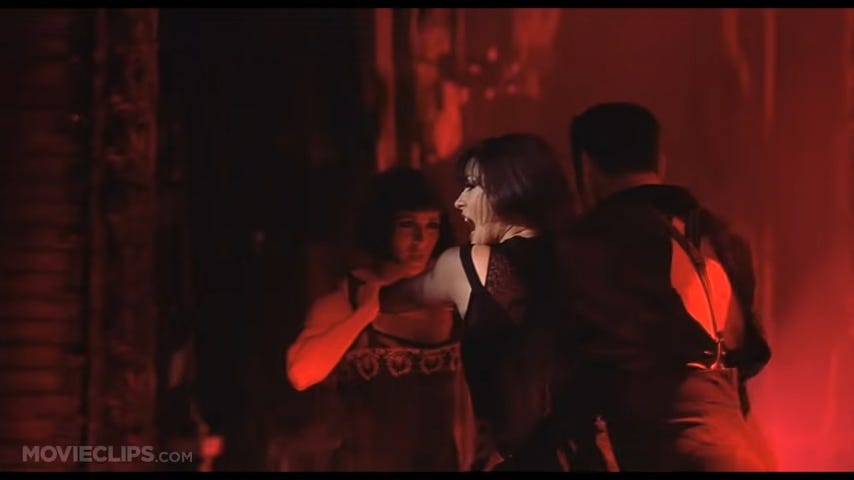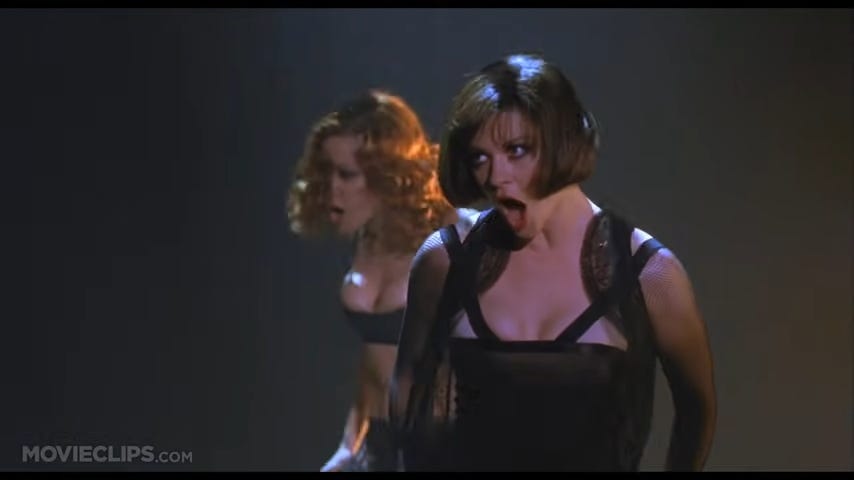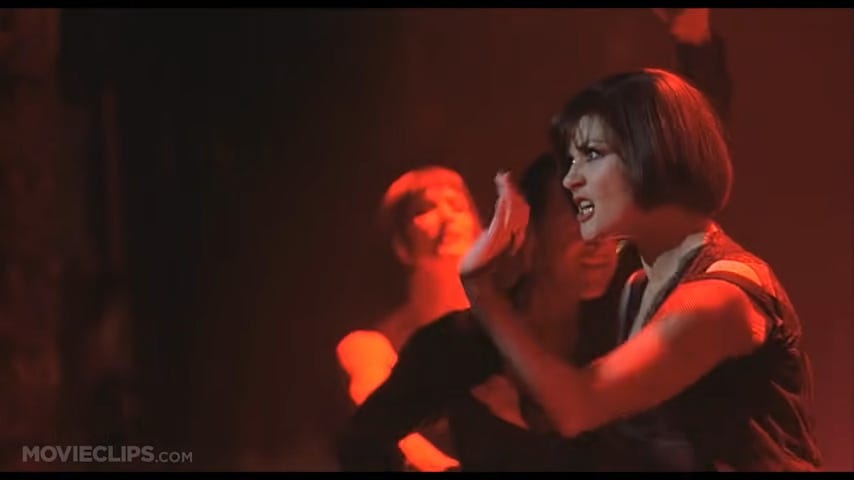A wise and beautiful woman once said: “You think it’s cool to hate things. It’s not. It’s boring. Talk about what you love and keep quiet about what you don’t.” This wise and beautiful woman was made up by the guy who played Ted Mosby on the TV series How I Met Your Mother, and was played by Elizabeth Olsen, who, as it turns out, is the perfect spokesmodel for having a vaguely inane sentiment turn into a meme of authority. (What are memes, if not screenwriting persevering?)
Now, if I were to make anything from the Josh Radnor motion picture Liberal Arts a guiding observation as it relates to my life, I’d probably go with the moment where Richard Jenkins, playing a middle-aged mentor of Radnor’s drifting post-college character, claims to have “never not felt 19” even as he continues to age toward supposed maturity and, eventually, presumed oblivion. That was the only part of the movie I really remembered at all until the gussied-up let-people-enjoy-things meme further darkened my already dim Twitter timeline. That said, beneath its insufferably lecturing tone, sock-puppeted through a talented actress, is something like what I’ll begrudgingly call truth: It is boring to hate things. Or at least, it is often boring to hate movies at great length or with great self-satisfaction. There are too many bad-movie podcasts full of yelling, one-star Letterboxd reviews full of pithy nothingness, and YouTube videos full of people who make YouTube videos to truly suggest otherwise. There is a place for the full pan, of course, but as the author of an occasional newsletter, I don’t feel like it’s worth using my platform, however meager, to call anyone’s attention to how much I hate something. That’s what my paying gigs are for.
So why am I writing to you today about The Little Mermaid (2023)?
I guess the easy out is that I don’t hate it. The Lion King (2019) filled me with such simultaneous revulsion and boredom that anytime I see a Disney Remake that features actual actors, even parts of them, delivering something resembling a human performance, my soul lingers in my body, refusing to leave, in hopes that the movie will somehow get better. And yes, “parts of actors delivering something resembling a human performance” is a pretty accurate description of Disney’s new take on The Little Mermaid. It delivers 20% of the charm of the 1989 animated original (itself not an absolute top-tier Disney cartoon for me, though the songs are up there) at 160% of the running time. Many of its notable changes are tweaks designed to pacify (or, in the mushmouthed parlance of one review I read this morning, “updated to reflect the times”), with little indication of anything about the original film that inspired this one—beyond that people seem to like it and therefore might be willing to pay money to see it once again rise from the briny deep, this time with extra-briny murk.
Believe it or not, it’s nonetheless difficult for me to completely begrudge this zombiefication. Most prominently, it will doubtless mean a hell of a lot to countless kids (and their parents) that this non-cartoon Ariel is played Halle Bailey, a Black actress and singer. Bailey is responsible for any currents of emotion flowing through this movie, and though I don’t know that The Little Mermaid gives her much to work with—literally, there are scenes where at least half of her character’s body is animated—she certainly has presence and, as Scuttle might say, a nice set of pipes. (Non-stolen.) There is a moment during the reprise of “Part of Your World,” one of many pantheon-level bangers in the Howard Ashman/Alan Menken songbook, where Bailey grasps at some rocks, ready to hoist herself up in defiance of what she’s told is the natural order (mermaids remaining underwater and in strict opposition to the surface world), and in this live-action translation of a famous cartoon image, you get a glimpse of the hormonal teenage desire that’s supposed to animate this story, whether the characters are actually animated or not.
I also like the new song she gets to sing in her head, after the sea witch Ursula (Melissa McCarthy) transforms her into a finless, normal-legged but mute human, granting her three days to silently win the heart of Prince Eric (Jonah Hauer-King), who Ariel has previously saved from drowning. There are some charming moments featuring the creepily CG-animated versions of Sebastian the crab (Daveed Diggs) and Scuttle the seagull (Awkwafina), including a pop-rap number that delighted me twice: first with its wordplay, and again with the possibility that the performative cringes it will inspire might actually be strong enough to send people into comas. As with almost any pointlessly faithful recreation of a previous film, the movie’s pleasures lie not in the fealty of the quoting nor the approximations of the familiar images, but spotting (if not always approving of) the way that the copy must somehow, inevitably deviate from the plan. (Except, again, in the case of The Lion King, where almost every single difference is an almost unfathomable diminishment.) It makes writing about these movies potentially very dull, whether it’s to pan them, or patiently explain what small sliver of them works.
So again, why make The Little Mermaid the subject here?
The reason is Rob Marshall.
Rob Marshall directed The Little Mermaid (2023), as well as Chicago (2002), Memoirs of a Geisha (2005), Nine (2009), Pirates of the Caribbean: On Stranger Tides (2011), Into the Woods (2014), and Mary Poppins Returns (2018). Most of his work has received multiple Oscar nominations (albeit not at the level of Chicago, which won the Academy Award for Best Picture for the year that saw the release of Adaptation, Minority Report, and 25th Hour, among others; not talked about enough in terms of Oscar cock-ups, as far as I’m concerned, probably because its main actual competition was Gangs of New York, which most people incorrectly think of as third-tier Scorsese, and The Pianist, a Roman Polanski film). Before he moved into features, he was a choreographer, and he specializes in musicals (which account for five of his seven movies) as well as Disney (which accounts for his last four in a row). Through its combination of music, Disney iconography, and visual effects, The Little Mermaid should represent an easy layup for Marshall—his version of the Tim Burton movies later in his career that feel a little too easy for his talents.
Marshall’s talents, however, feel very much challenged by The Little Mermaid—and to my eyes, these challenges emerge in every one of his films, to some degree or another. It’s a surprisingly common trait in other recent movie musicals directed by choreographers, but especially baffling given Marshall’s experience and pedigree: His movies are eager to show the fact that choreography is occurring, and reticent to show how or why, or even offer much direction to the human eye. The Little Mermaid is supposed to be sort of a hyperreal tour of an underwater kingdom with photorealistic properties but fantastical sights, colors, and sounds. Beyond the much-remarked-upon fact that much of the film’s world is murkier and less bright than its animated counterpart, Marshall rarely seems to get a handle on what, exactly, he wants us to look at besides, like, the screen. The Little Mermaid doesn’t slavishly imitate as many frames from its counterpart as The Lion King does, but Marshall’s replacements are static enough to convince you that he must be imitating something. There’s no point of view, no momentum, no meaning behind most of the images beyond whatever the actors are able to smuggle in between senseless cuts.
This is especially noticeable during the musical numbers, a form Marshall has somehow failed to master after making multiple big-budget musicals. “Under the Sea,” the signature uptempo showstopper from The Little Mermaid, has actually been substantially reworked here—not in lyrics, but in arrangement and accompanying production. While the animated film had a number of underwater extras literally performing music (and in some cases singing backup) alongside Sebastian the musical crab, the new version has them performing more nature-based (and, because of this, more abstract) forms of dancing, with Ariel providing backing vocals, making her appear more drawn into Sebastian’s pro-undersea argument; it’s not quite a duet, but Bailey’s voice is a welcome addition. Yet rather than following that re-arrangement to make Ariel and Sebastian the number’s dual focal points, Marshall listlessly cuts around to various CG creations, which are now… not quite doing any of the stuff the song says they are? And he doesn’t cut with any great tempo or sense of exhilaration, either; there’s nothing like the rapid-fire crescendo of cuts that accompanies the finale of the 1989 version. He barely finds a way to show Ariel sneaking off towards the end of the song, a crucial component in the earlier iteration, and as a result, almost nothing about the number feels natural. This might sound like a silly criticism of a musical number where a newt plays a flute and a carp plays the harp. But in the previous version, it was clear exactly when the newt was playing a flute and the carp was playing a harp, and Ariel was momentarily charmed by this but eventually bored. In the 2023 version, Ariel is harmonizing with Sebastian’s whole vibe, and still peaces out. Maybe it’s because she sees how boring the whole thing is turning out; maybe it’s because things just happen because they’re supposed to happen. If Marshall doesn’t really believe in this shit, why should we?
This problem is not unique to Marshall’s latest film; it’s only especially noticeable here because it’s working from such familiar iconography, shots that were composed with an animator’s artistry and freedom from the limits of the human form. I won’t bore you with an extended tour of Marshall’s filmography, but take another look at Chicago, by far his most acclaimed film (and by most measures, still his biggest hit). Its razzle-dazzle musical numbers are full of shots that mean nothing, where the camera has seemingly captured an image with the sole purpose of having something else to cut to. In “Cell Block Tango,” why are there so many shots of Catherine Zeta-Jones from the lower side of the makeshift stage, intercut with more head-on compositions?
Is it a particularly striking composition? Maybe compared to a fixed, unchanging shot. Does it tell us anything about the character, or feed us a meaningful image? Does it do a better job than the dancing itself in terms of giving the sequence a sense of movement or momentum? Not really. The answer seems to be, we see her from that angle because there was a camera there. I’m not at all one of those “let us see the dancing!” people; movie musicals can show us so much more than dancing with productively fast editing, and I generally love the work of Baz Luhrmann, who’s certainly no stranger to cutting around different vantage points. But I can usually detect the reasons behind Luhrmann’s frenzy, where the images feel more like genuine montage, or sometimes emotional punctuation.
(I once got into a mostly good-natured Twitter argument about this very subject: The directing in Chicago vs. the directing in Moulin Rouge! I was told Marshall understands “spectactorship” and Luhrmann does not. I am not sure what this means, unless it means that Marshall communicates the experience of spectators repeatedly changing seats during a musical number.)
Occasionally, Marshall stays out far enough out of his own way to give him the benefit of the doubt. It really felt, at times, like he was trying to avoid this odd diffusion of focus with his adaptation of Into the Woods, which was not especially interesting on a visual level—quite stagebound, in fact!—but at least didn’t feel like the director was making us watch as he distractedly craned his neck around those sets, trying to figure out his visual language on the fly. Most of the time, though, Marshall seems profoundly uninterested in the idea that images might actually mean something. Steven Spielberg has spoken about a ”master image,” a shot that can sum up a film, or even a filmmaker’s entire career, in a single moving image. Now, not every journeyman director has the leeway to be messing about with what single image encapsulates their entire deal, obviously. But Marshall has commanded some enormous budgets and resources, and has obvious areas of interest or perceived expertise that he has repeatedly explored; you might think some kind of personality or preference would emerge. Yet on a moment-by-moment basis, he seems to actively resist this kind of image-making. There are times where you can practically feel him swerving, in his cutting, to avoid it, which may be why his movies can be edited at such a rapid clip and still feel so tedious, why his razzle-dazzle sights feel so devoid of genuine magic. Countless decisions go into every minute of screen time, so there’s something perversely remarkable about giving the appearance of never actually making any.
This also might make him perfect for the goals of something like The Little Mermaid; the whole Disney Remake Project has seemingly embraced the idea that images are not designed to have their own semiotic meaning; they exist to recreate, to erect homage, to remind. No wonder Halle Bailey’s performance feels too disconnected to be reasonably called great, or even star-making; she’s doing a re-enactment work, where bringing in too much of her own humanity would be considered akin to adding an alien invasion to the climax of a World War I epic by the filmmakers, I mean; obviously I’d be fine with this). Kids who will be enchanted by Bailey’s presence deserve images that have their own power. They deserve decisions worth loving, or hating, beyond their initial shimmer and fade.







